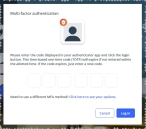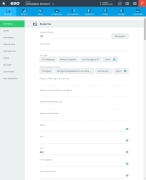Collect demographic information
You need to capture the patient's demographic information to uniquely identify that person from any other patients at the scene.
-
 (If you have not done so already) Access the EHR module in the ESO Suite.
(If you have not done so already) Access the EHR module in the ESO Suite.
-
Do one of the following.
-
(If you are already working in the ESO Suite) Click the Home icon in the upper left corner of the screen.
-
 (If you have not yet logged in) Log in to the ESO Suite.
(If you have not yet logged in) Log in to the ESO Suite.
-
In a web browser, go to https://www.esosuite.net/EsoSuite.
The ESO Suite login screen appears.
-
Enter your user name, password, and agency name, then click Let's Go.
If MFA is enabled, the Multi-factor authentication dialog box appears, displaying one or more methods you can use to verify your login credentials. The number of methods that appear in the dialog box depends on what MFA methods your ESO Suite administrators enabled in the Admin module.

Click graphics
to open them.Information on enabling MFA and specific MFA methods is available in the Admin module online help, in Configure multiple-factor authentication.
Note: If your ESO Suite administrators have disabled MFA ("opted-out"), this dialog does not appear.
-
(If the Multi-factor authentication dialog box appears) Depending on which buttons appear in the dialog box, verify your login in one of the following ways.
 With an authenticator application.
With an authenticator application.
-
Click MFA verification via authenticator app.
The dialog box updates with boxes for entering the numbers of the authentication code, and the ESO Suite sends an authentication code to the authenticator application installed on your device.
-
Open your authenticator application and note the authentication code currently displayed.
-
Enter the authentication code displayed in the authenticator application.
-
Click Log In.
 With a text message (SMS).
With a text message (SMS).
-
Click MFA verification via SMS.
The dialog box updates with boxes for entering the numbers of the authentication code, and the ESO Suite sends an authentication code to the phone number recorded in your PM records and identified with MFA codes.
-
Enter the authentication code sent to your MFA-registered phone number.
-
Click Log In.
 With an email message.
With an email message.
-
Click MFA verification via email.
The dialog box updates with boxes for entering the numbers of the authentication code, and the ESO Suite sends an authentication code to your agency or department email address, recorded in your PM records.
-
Enter the authentication code sent to your agency or department email address.
-
Click Log In.
-
-
The ESO Suite landing screen appears.

Click graphics
to open them.Note: If MFA is enabled, you can access and manage your MFA options through the PM module, on the Settings > Account page, as described in Manage a user account. If your agency or department has enabled MFA but has not purchased the full-featured version of the PM module, you can access your own MFA settings by clicking Change my Multi-Factor Authentication settings on the landing screen, then using the Settings > Account page that appears. If your agency has not enabled MFA, the Change my Multi-Factor Authentication settings link does not appear on the landing screen.
-
-
On the top side of the home screen, click EHR.
Tip: If your screen or browser window is too narrow to display all your agency's ESO Suite module icons, an options icon appears on the right side of the icon bar. If you click the options icon, a menu appears containing additional module icons.
The EHR screen appears, displaying a list of patient records in the EHR module. The most-recent records appear at the top of the list.
Different record status icons can appear in the list.
Icon Status Unlocked/DraftThe patient record exists in the ESO Suite database, and all crew members listed in the patient record may edit all fields in the record. ESO Suite administrators and personnel with security roles of either
EHR SupervisororEHR Managercan edit non-clinical fields.MobileThe patient record exists on the mobile device, and has not been synchronized with the ESO Suite database. ESO Suite administrators, personnel with security roles of either
EHR SupervisororEHR Manager, and all crew members listed in the patient record can only access a print view of the record.Once the Mobile record synchronizes with the ESO Suite database. the record reflects its current status.
LockedThe patient record exists in the ESO Suite database, and is locked. Only non-clinical fields can be edited by crew members listed in the patient record, ESO Suite administrators and personnel with security roles of either
EHR SupervisororEHR Manager.
-
-
 (If you have not done so already) Add a new patient record, or search for the existing patient record you want to work with.
(If you have not done so already) Add a new patient record, or search for the existing patient record you want to work with.
Information on adding or opening a patient record is available in Add a patient record and Search for a patient record.
The patient record opens and displays the Incident tab, with the Response bookmark selected in the left pane. Fields appear in the right pane for specifying basic information about the incident
If you manually created a new patient record, the Incident Number and State Tracking Number fields populate automatically with ESO Suite-assigned values. You must enter data in all other required fields.
If you imported data from a CAD system, the Incident Number field populates with the data from that source. Other fields in the EHR module may also populate from these sources, depending on what data was recorded in them before the data was imported into the EHR module.
-
At the top of the page, click the Patient tab.
The contents of the Patient tab appear, set to the Demographics bookmark in the left pane.
-
 (Optional) Import patient data from a previous encounter.
(Optional) Import patient data from a previous encounter.
If you have a patient that has a recurring health problem, such as a history of heart attacks or mini-strokes, you may have responded to that patient for treatment and transport multiple times in the past. If you recognize the patient's name or address from earlier encounters, it may be faster to search for PCRs for the patient and import their information from earlier records, than to manually type in their information for this new incident.
Note: The EHR module searches locked patient records looking for last name, SSN, and DOB matches.
-
Under Patient Import, click Search.
The Select a record dialog box appears, listing any patients in the EHR module records matching the last name, DOB, and/or SSN information you specified for the patient in this record.
-
Select the patient's PCR listing, then click Import.
Fields in any section on the Patient tab populate with information already captured in the PCR from the selected encounter.
Example: The patient was last encountered on September 12, 2022, and information about his demographics, contacts, medical history, allergies, medications, and so forth were recorded then. When you import the patient's record on that date for the encounter on November 11, 2022, all the relevant fields populate automatically, and you only need to review and possibly update the data for the current encounter.
-
-
 Manually specify the patient's name, social security number, and birth date.
Manually specify the patient's name, social security number, and birth date.
-
In First Name, Middle Name, and Last Name, type as much of the patient's name as known.
-
For Social Security Number, click the number pad icon to the right of the field, then enter the appropriate numerical values from the number pad dialog box that appears to specify the patient's government-issued social security number.
-
Specify the date of birth in one of these ways.
 Specify the patient's precise birth date.
Specify the patient's precise birth date.
-
For Date of Birth, click the number pad icon to the right of the field, then enter the appropriate numerical values from the number pad dialog box that appears to specify the patient's birth date.
The EHR module calculates the person's current age based on their birth date, and displays the value in Age.
 Estimate the patient's age.
Estimate the patient's age.
-
Click Estimate Age.
The Age field disappears, and Estimated Age and Unit appear in its place.
-
For Estimated Age, click the number pad icon to the right of the field, then enter the appropriate numerical values from the number pad dialog box that appears for your best guess at the patient's age.
-
For Unit, click the field or the list icon to the right of the field, then select the appropriate single option from the menu that appears to indicate whether the estimate is based on years or months (for infants and toddlers).
-
-
-
 Specify the patient's gender, weight, race, and ethnicity.
Specify the patient's gender, weight, race, and ethnicity.
-
For Gender, click Male, Female, or Other and click the field or the list icon to the right of the field, then select the appropriate single option from the menu that appears.
-
For Weight, type the person's body weight in either pounds or kilograms.
The EHR module automatically calculates the weight in the units you did not use, so that the weight is available in the PCR in both metric and English units.
-
(If the patient is a child) For Pediatric Color Coding, click the field or the list icon to the right of the field, then select the appropriate single option from the menu that appears to choose the color corresponding to the length-based tape used treating children.
This tape is commonly referred to as the Broselow tape, and allows EMS workers to quickly obtain various emergency tube sizes and medication doses for a patient’s age and weight.
Note: This field appears in the EHR module only if your ESO Suite administrator enabled it in the Admin module, under EHR > Patients Tab > Configurable fields.
Information on enabling EHR fields is available in the Admin module online help, in Configure tabs.
-
For Race, click the list icon to the right of the field, select all the appropriate options from the menu that appears, then click OK or click outside the menu to specify the patient's race, as defined by the US OMB.
Note: For NEMSIS 3-compliant agencies, you can select more than a single race option.
-
For Ethnicity, click the field or the list icon to the right of the field, then select the appropriate single option from the menu that appears to specify the patient's , as defined by the US OMB.
Ethnicity is an ethnic classification or affiliation. Ethnicity designates a population subgroup having a common cultural heritage, as distinguished by customs, characteristics, language, common history, and so forth. Currently, Hispanic/Latino is the only OMB designation for ethnicity.
-









